ALTHOUGH it is beyond dispute that the first Christian universities exhibited many striking features in common with the Muslim centres of learning which arose in the tenth and eleventh centuries, there has hitherto been a lack of documentary evidence to show that these resemblances were anything more than a series of coincidences, inevitably produced by the relationship between teacher and taught in any country. This is in spite of the fact that Arabic textbooks in Latin translation were widely used in the new Christian centres of learning.
These resemblances are, however, sufficiently remarkable. Features of institutions of higher learning to be found among the Muslims which are later to be found in Christian Europe include the organization of foreign students into ‘nations’“1”the wearing of distinctive dress by teachers, the practice of imparting free instruction without exacting payment from pupils, and the granting to students, who had successfully completed a course of study, of a licence to teach (known in Arabic as ijaza; in Europe as licentia docendi, the earliest form of degree) “2”
It would be reasonable to suppose that these early methods of university organization were introduced to Christian Europe by Christian scholars returning to Paris, Oxford, and elsewhere, scholars such as Adelard of Bath, Robert of Ketton, Michael Scot, etc., but they have unfortunately left no written record concerned with the organization of Arab learning.“3” Their writings are concerned rather with the substance of that learning, the form of Latin translations of Arabic works of science and philosophy hich they had studied.
The late Professor Alfred Guillaume suggested that the beginnings of answer to the problem of the connection between Eastern and Western versities might be found if the origin of the scholastic use of the term lo.ccalareus’ or ‘baccalaureus’ could be explained satisfactorily.“4” This term the sense of a holder of the lowest university degree first appears in the thirteenth century in the University of Paris in the system of degrees established in 1231 by the bull Parens scientiarum of Pope Gregory IX,“5” although the word was probably used colloquially earlier than this. Guillaume’s dry observation that the etymology of this word given in the Oxford English Dictionary ‘can hardly be said to explain [this term] satis-factorily’ (it seeks to derive the word from vacca ‘cow’) is echoed by many European authorities.“6” Guillaume went on to suggest that the origin of the term ‘baccalareus’ should be sought in an Arabic phrase used in an Islamic academic context, and proposed the phrase ‘bi-jiaqq al-riwaya’ (= ‘the right to teach on the authority of another’) as being one that gave a suitable meaning and a tolerable assonance with the Latin term. He admitted, however, that he had never seen this phrase used in any Arabic text.

It is now possible to show that a virtually identical phrase was not only used in Arabic, but was a technical term (with the above meaning) used over a period of at least six centuries in precisely the kind of document which supports Guillaume’s hypothesis, viz, the ijaza, or diploma con-ferring the right to teach.
In a manuscripts“7” containing the text of the Siqt al-Zand of Abü al-Alã’ al-Ma’arri we find on fol. 250v an ijaza carrying the date A.H. 542 (= A.D. 1147)“8” and containing the phrase bi-hqq riwayatihi. Its full text is as follows:
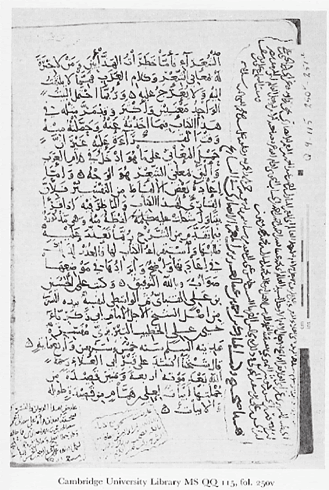
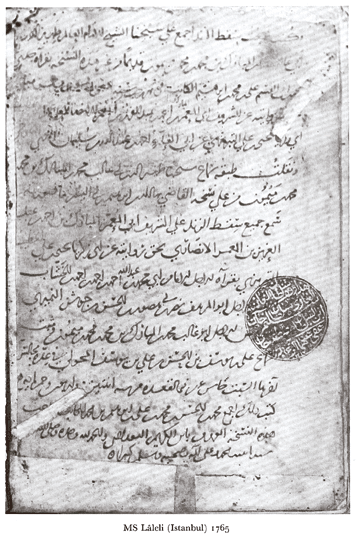
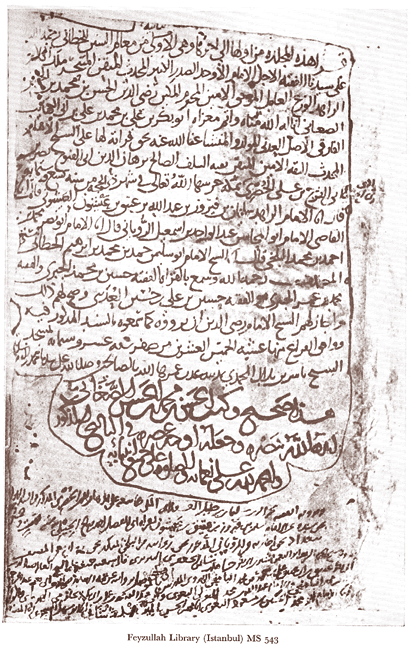
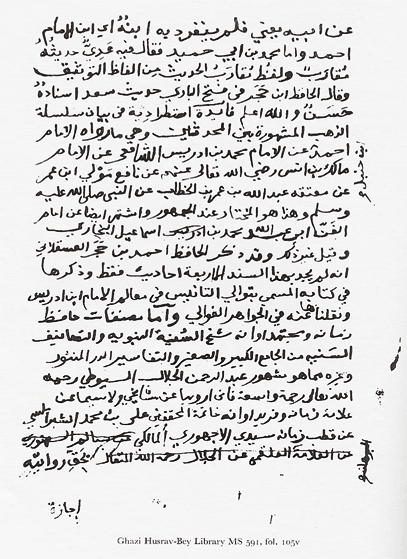
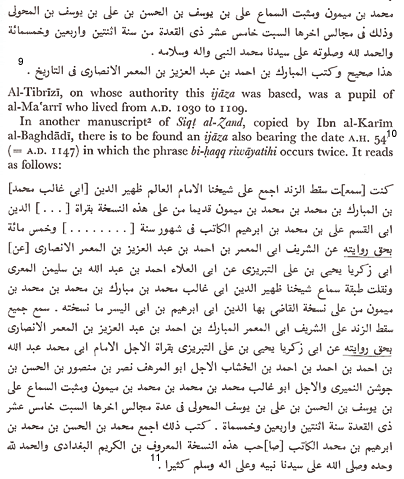
A manuscript“12” of the Kitab Sibawayh copied by Zayd ibn al-Hasan ibn Zayd al-Kindi in A.H. 595 (== A.D. 1198) preserved in the Bibliothèque Nationale in Paris contains an ijaza in which the phrase bi-haqq riwayati occurs. The text of this ijaza reads as follows:
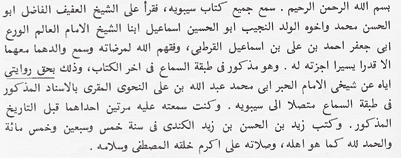
A manuscript“13” containing a copy of Ma’alim al-sunan of Hamd al-Khattabi from the Feyzullah Library contains an ijaza, bearing the date A.H. 56 (= A.D. 1160), which twice uses the phrase bi-haqq riwayatihi. The relevant passage reads:

Manuscript 591 of the Ghazi-Husrav Bey Library in Sarajevo, which contains twenty different items of a miscellaneous nature,“15” includes an ijaza“16” issued to Ibn Himmãt al-Dimashqi on the 10th of Ramadan 1134 (=A.D. 1721), by the Egyptian faqih Ibn al-Mayyit. The phrase bi-haqq riwayatihi occurs on fol. 105v of this manuscript.“17” The relevant passage reads as follows:

The phraseology used in these ijazat suggests that Guillaume’s proposal may well indicate the true origin of the puzzling nounbaccalareus in the Arabic adverbial phrase bi-haqq al-riwaya, and it is worthy of note that Rashdall,“19” while stating that the etymology of the word is doubtful, thought it likely that it was first used as a slang term; this is precisely the way in which the Arabic bi-lzaqq al-riwaya might have been used collo-quially by scholars, for want of an immediately convenient Latin equiva-lent, in the same way that European merchants adopted Arabic terms such as ‘tare’ (from tarh), ‘tariff’ (from ta’rif), ‘mohatra’ (from mukhatara), ‘cheque’ (from sakk), ‘arsenal’ (from dar al-sina’a), etc., without troubling to think of suitable European renderings of these useful words.
The intermediate stages by which ‘bi-haqq al-riwaya’ could have been transformed into ‘baccalareus’ cannot be determined with absolute cer-tainty, but we suggest that the following considerations may illustrate the manner of this progression. In the first syllable of baccalareus the change from bi-haqq to bacc with loss of ‘h’ can be paralleled in other Arabic borrowings into medieval Latin.“20” The unassimilated ‘1’ in the second syllable of the word can be paralleled in many Latin borrowings from Arabic in literary sources ;“21” if, however, in accordance with Rashdall’s suggestion baccalareus arose from a colloquial usage, we would have to assume the likelihood of Spain being the area in which it was first used, and that the assimilation of the lam of the article to a following ‘sun’ letter did not occur in the spoken Arabic of Spain. In regard to ‘riwaya’ meta-thesis may well have occurred. Thus the following progression could be envisaged: bi-haqq al-riwaya > b-haqq lürëa > baccalure [? a] > baccalareus.
The study of ijazat by European scholars has been neglected,“22” and it may well be that further research into this class of document will throw more light on the relationship between the early institutions of higher learning in Islam and those of medieval Christian Europe.
—————
1) See P. Kibre, The Nations in the Mediaeval
Universties (Cambridge, Mass., 1948).
2) Cf. A. Guillaume, Philosophy and Theology’ in The Legacy of islam,
1st edition, ed. T. Arnold and A. Guillaume (Oxford 1931), pp. 244-5
3) Ibid., p. 244
4) Ibid., p. 244, footnote 1. In the second edition of The Legacy
of Islam, ed. J. Schacht and C. E. Bosworth (Oxford, 1974),
5) See L. Halphen, A travers l’histoire dv Moyen Age (Paris, 1950),
p. 304; H. Grundmann, Vom Ursprung der Universjtãt im Mittelalter [Berichte
uber die Verhandlungen der Sächsischen Akademie der Wissenschaften zu Leipzig,
Phil.-hist. Kl., Bd. 103, Heft 2 (Berlin, 1957)], p. 55 Encyclopaedia Britannica
(11th edition, 1910), s.v. Bachelor.
6) In the sense that they confine themselves to recording that the
word is medieval Latin and do not venture beyond this; see, e.g., Brockhaus
Enzyklopadie, vol. a (Wiesbaden, 1967), s.v. Bakka-laureus; Der Grosse Duden,
vol. 5 (Fremdwörterbuch) [Mannhemm, 1960], s.v. Bakkalaureat; Nouveau Larousse
Universel, vol. i (Paris, 5948), s.v. Bacca-lauréat; Encyclopaedia Britannica
(1970), s.v. Bachelor, etc. The Spanish Enciclopedia del Idioma, vol. i
(Madrid, 5958), s.v. Bacalario, proposes the other-wise discounted suggestion
that the origin of the term is to be soughi in the compound vacca (= berry) +
laureus (= laurel); this is repeated in Enciclopedia
Universal Ilustrada Europeo-Americana, vol. 7, S.v.Bacalaria.
7) Cambridge University Library MS. QQ 115. For a description of
this valuable manuscript see W. Wright, Facsimiles of Manuscripts and
Inscriptions (Oriental Series), London, 1875—83, in the album of the
Palaeographical Society, Plate XXXV, where it is stated that the manuscript was
written in A.H. 475 (= A.D. 1082—3). In his Handlist of the Muham-madan
Manuscripts in the University Library, Cambridge (Cambridge, 1900), p. 19, E.
G. Browne gives an inaccurate notice of this manuscript. He was apparently
unaware of Wright’s earlier work.
8) i.e. at a period ‘ou, ni dans les faits ni dans las mots, il
n’est encore question d’Universités [occiden. tales]’ in the words of L.
Halphen, op. cit., p. 299.
9) See Plate No. 1 This passage is reproduced by Stern in the
course of his detailed description of this manuscript. See S. M. Stern ‘Some
Noteworthy Manuscripts of the Poems of Abdul Ala al-Ma’arri in Oriens, vii
(1954), p. 328 N.B. Stern omits in error the phrase al-ajal al-imam at the
begining of the passage.
10) Ms. Laleli 1765 (Istanbul). For details of this manuscript see
O. Rescher, ‘Mitteilungen aus Stambuler Bibliotheken in ZDMG 64 (1910), p. 519;
Stern, op. cit, 336 where the message cited here ins reproduced.
11) See Plate No. II
12) MS. B.N. 5068, fol. 1. See G. Vajda, Certificates de Lecture et
de Transmission dans les Manuscrits Arabes de la B.N. de Paris (Paris, 1956),
p. 48. The passage given here is quoted by S. al-Munajjid, Ijazat al-Sama fi
al-Makhtutat al-Qadima in RIMA, i (1955), pp. 245f. who however reads wasbain
as wtsain.
13) MS. No. 543. The text of this ijaza was
published by H. Ritter in his article ‘Autographs in Turkish Libraries’ in
Oriens, Vi (1953), pp. 84—6.
14) See Plate No. III
15) For a full description of this manuscript and its contents see
K. Dobraca, Fifris al-Makhtutat al-Arabiyya wa-l-Turkiyya wa-l-Farisiyya, vol.
i (Sarajevo, 1963), pp. 374-80
16) The full text of this document, together with an English
translation, has been published by the present writers in Le Muséon, lxxxvii
(1974), pp. 445-65.
17) Attention may also be drawn at this point to the term al-majlis
al-amm (= a general gathering for study) which is used in the Sarajevo
manuscript (fol. 106r). This phrase shows some resemblance to the original name
of the European University, the studium generale, and the meaning of Arabic
phrase is identical with Rashdall’s definition of studium generale: ‘a place
where students from all parts are recieved’. See H. Rashdall, The Universities
of Europe in th eMiddle Ages, ed. F.M. Powicke and A.B. Emden, vol. i (Oxford,
1942), p.6. See also H. Wieruszowski, The Medieval Universities: Masters,
Students, Learning (Princeton 1966), p. 16 and A.B. Cobham, The Medieval
Universities (London, 1975), pp. 23-24.
18) See Plate No. IV.
19) See Rashdall, op. cit., pp. 207—8.
20) See J. D. Latham, ‘Arabic into Medieval Latin’ in Journal of
Semitic Studies, xvii (5972), p. 38, Additional note (ii). We are indebted to
Dr. Latham for a number of valuable suggestions in regard to this paragraph,
which he has kindly discussed with one of the present writers.
21) See ibid., p. 38, Additional note (i); cf. such Medieval
examples as althemen from ath-thaman (p. 53), , alszarar from as-si’r (p. 52).
22) See C. Vajda, The Encyclopaedia of Islam (2nd edition), s.v.
Idjaza. See also al-Munajjid, op. cit.,
